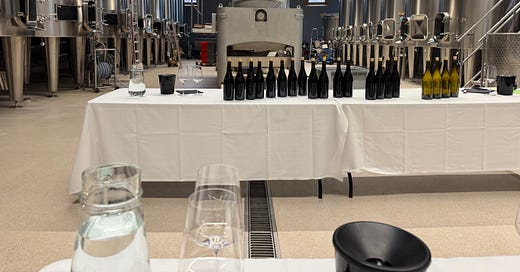Jeremy Seysses said that the quantities in 2023 surprised everyone: there were no more clusters than in 2022, which was already a large harvest, but the clusters in 2023 were very big, probably due to the amount rain throughout the year. The estate made the maximum permitted for yield, even though it had done a green harvest, a situation that was not uncommon in 2023.
He continued that there needs to be some revision to the maxim that low yields are always desirable: in cold years, low yields are advantageous, but in warm years, they are not. The reason is that in warm years with large yields, sugars move so fast at harvest that producers can barely pick all the grapes within desired sugar ranges; with low yields low in warm years, sugars move even faster, meaning that some wines would be too alcoholic and possibly deficient in acidity.
The harvest at Dujac started on 1 September with the Puligny-Folatières, then paused until the 6th, and finished on the 15th.
The season was problem-free until a heat wave in August. It was the latest heat wave that Burgundy has had in August, and there was some shriveling of grapes on south sides of the bunches. The damaged fruit was rigorously sorted out, but Jeremy says some may have gotten through the sorting proceess to give higher alcohol. Thus, the Gevrey-Combottes should have come in at 13.2º based on samples, but came in at 14º. As a consequence, for the remainder of the harvest, Dujac was even more rigorous in sorting. Most of wines are 13-14º, but there were even more above 14º in 2023 than in 2022. Another change adapting to the new reality is that maceration times are shorter now than they previously had been, 10-12 days more often than not. As of the end of November when I tasted these wines, Jeremy was looking to bottle these wines at the end of March 2025.
For the Gevrey-Combottes and the Vosne-Malconsorts, malolactic fermentations were very late, finishing only around harvest time in 2024.
With respect to the whites, Jeremy observed everyone wants tension in the wines now in age of ripeness. He finds 2023 comparable to 2022 in style. The acidities are “correct”, and did do some acidification.
For the reds, Jeremy regrets not doing a bit more whole cluster in 2023. The average amount is around 75%. New oak is 20% for village wines, 40-70% for premier cru, and 75% for grand cru.
Notwithstanding Jeremy’s forthrightness about the challenges of the vintage and global warming, these are, as usual, wines that show their terroir and are among the top representatives of each appellation.
Domaine Dujac whites:
2023 Morey-Saint-Denis
Smooth, silky, drawn texture, some tropical fruit, enough freshness and acidity, (88-90)
2023 Puligny-Montrachet 1er Cru Folatières
The vines average 20 years of age. Slim profile, some minerality, good density, relatively closed today. (89-92)
2023 Puligny-Montrachet 1er Cru Combettes
Vines are 75 years old. Richer, denser, almost chewy, white fruits. (91-94)
2023 Morey-Saint-Denis 1er Cru Monts Luisants
Spicy nose. Dense, medium-full weight, crisp, fresh. Very attractive. (91-93)
Dujac Fils & Père reds:
Next we turned to the wines from the négociant operation, Dujac Fils & Père. 2023 is last year for most Dujac F&P wines; Jeremy is finding it hard to get value in purchase of fruit, and allied with that, with so much demand for the fruit, growers make less effort to achieve top quality.
2023 Chambolle-Musigny
Crisp red fruits. Medium weight, smooth texture, but also some grip. (88-90)
2023 Morey-Saint-Denis
Perhaps a bit more weight than the Chambolle, lovely caressing texture, darker fruit than Chambolle. Good length in mouth. Attractive. (89-92)
2023 Gevrey-Chambertin
Rounder than others, darker fruit, a little softer. (86-89)
2023 Nuits-Saint-Georges 1er Cru Aux Cras
This is the one wine that will continue to be issued under the Dujac Fils & Père label. The wine is round, pure, balanced, good freshness. It features earthy red fruits typical of Cras, and a creamy texture, but it is not lacking acidity (91-94)
Domaine Dujac reds:
2023 Chambolle-Musigny
Good density, fresh, dark fruit. Excellent village wine. This wine is entirely from the Drazées lieu-dit; Frémières has been replanted and will re-enter the blend in 2026. (90-92)
2023 Morey-Saint-Denis
Floral nose, fresh, mouth, red fruits, creamy but with good acidity beneath. (91-94)
2023 Morey-Saint-Denis 1er Cru
Dense, pure, beautiful red and dark fruit, excellent concentration. (92-95)
2023 Chambolle-Musigny 1er Cru Les Gruenchers
Vineyard planted in 1930s. Complex nose, rich, pure, dense. Still quite primary. (93-96)
2023 Gevrey-Chambertin 1er Cru Aux Combottes
Some reduction, don’t feel the alcohol. Red fruits, good grip. (91-93)
2023 Charmes-Chambertin
No young vines in this wine. Excellent minerality, good depth, red fruits, nice precision. (93-96)
2023 Vosne-Romanée 1er Cru Les Beaux Monts
Creamy but with Beaux Monts minerality, luminosity, pure, almost crystalline, dark fruits. Superb example of Beaux Monts. (94-96)
2023 Echézeaux
Dark fruits, pure, good grip, some spice. (94-96)
2023 Vosne-Romanée 1er Cru Aux Malconsorts
Late malos. Great expression of Malconsorts, dark fruits, firm, crisp. (94-96)
2023 Bonnes-Mares
Outstanding completeness, pure, gentle. (95-98)
2023 Clos St-Denis
Clos Saint-Denis spiced nose and mouth, red fruits. (95-98)
2023 Clos de la Roche
Firmer body, red and a bit of dark fruit, more minerality, excellent length, good grip, good energy. (96-98)



